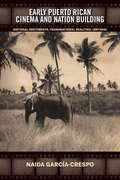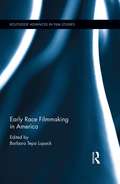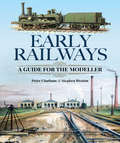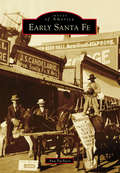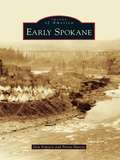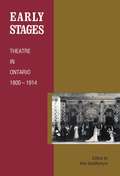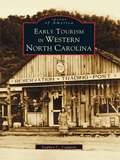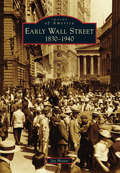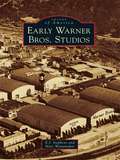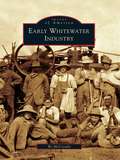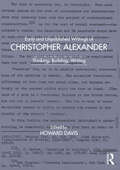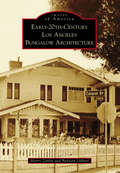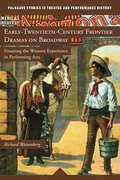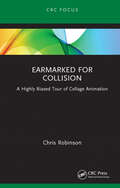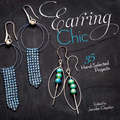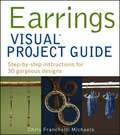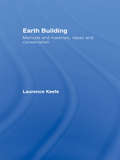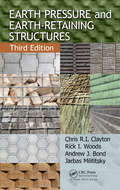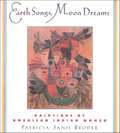- Table View
- List View
Early Puerto Rican Cinema and Nation Building: National Sentiments, Transnational Realities, 1897-1940 (Bucknell Studies in Latin American Literature and Theory)
by Naida García-CrespoEarly Puerto Rican Cinema and Nation Building focuses on the processes of Puerto Rican national identity formation as seen through the historical development of cinema on the island between 1897 and 1940. Anchoring her work in archival sources in film technology, economy, and education, Naida García-Crespo argues that Puerto Rico’s position as a stateless nation allows for a fresh understanding of national cinema based on perceptions of productive cultural contributions rather than on citizenship or state structures. This book aims to contribute to recently expanding discussions of cultural networks by analyzing how Puerto Rican cinema navigates the problems arising from the connection and/or disjunction between nation and state. The author argues that Puerto Rico’s position as a stateless nation puts pressure on traditional conceptions of national cinema, which tend to rely on assumptions of state support or a bounded nation-state. She also contends that the cultural and business practices associated with early cinema reveal that transnationalism is an integral part of national identities and their development. García-Crespo shows throughout this book that the development and circulation of cinema in Puerto Rico illustrate how the “national” is built from transnational connections. Published by Bucknell University Press. Distributed worldwide by Rutgers University Press.
Early Race Filmmaking in America (Routledge Advances in Film Studies)
by Barbara LupackThe early years of the twentieth century were a formative time in the long history of struggle for black representation. More than any other medium, movies reflected the tremendous changes occurring in American society. Unfortunately, since they drew heavily on the nineteenth-century theatrical conventions of blackface minstrelsy and the "Uncle Tom Show" traditions, early pictures persisted in casting blacks in demeaning and outrageous caricatures that marginalized and burlesqued them and emphasized their comic or servile behavior. By contrast, race films—that is, movies that were black-cast, black-oriented, and viewed primarily by black audiences in segregated theaters—attempted to counter the crude stereotyping and regressive representations by presenting more authentic racial portrayals. This volume examines race filmmaking from numerous perspectives. By reanimating a critical but neglected period of early cinema—the years between the turn-of-the-century and 1930, the end of the silent film era—it provides a fascinating look at the efforts of early race film pioneers and offers a vibrant portrait of race and racial representation in American film and culture.
Early Railways: A Guide for the Modeller
by Stephen Weston Peter ChathamHistory, references, and resources for modeling the earliest decades of British rail travel. This is a guide to the earliest period of railway history, from the very beginnings of steam traction at the start of the nineteenth century, up to about 1880. Over these few decades the railways evolved from something that at the start was markedly different, into a scene that any present-day railwayman would recognize. It is a time with much to commend it from a modeler&’s point of view. The trains were much shorter and therefore easier to fit into the limited space most of us have available as, correspondingly, were the station layouts, especially at the beginning of the period. Covering infrastructure, locomotives, carriages, and wagons, this is an invaluable resource for those who want to explore the modeling possibilities of nineteenth-century railways.
Early Reno
by Nevada Historical Society Docent CouncilIn 1868, Reno was a rough railroad town located on the new Central Pacific railroad line and quickly became the transportation hub for the greatest silver strike in the world, the Comstock Lode in Virginia City. By the early 1900s, Reno was the state's financial and industrial center. The automobile and the arrival of the Lincoln and Victory Highways made Reno a convenient place for a quick divorce, and between 1910 and 1970, it was known as the divorce capital of the world. Gaming thrived in Reno's back rooms and alleys since its earliest days, and became the state's major economic force after it was legalized in 1931. Known as the "Biggest Little City," Reno was famous as a place where one could do things that were difficult to do anywhere else.
Early San Juan County
by Laverne Tate San Juan County Historical SocietySan Juan County was established in 1880 following the famous winter trek and steep descent through the Hole-in-the-Rock Trail to Bluff, Utah. Behind the settlement of this community by the San Juan River is a story of tenacity, determination, and hardship. The Hole-in-the-Rock was a sandstone crevice discovered fortuitously by pioneers when a wild ram escaped its pursuers and descended to the river by that route. After blasting, building up the grade, and lowering by ropes, the wagon train finally emerged through the crevice to the river below and finished the last difficult miles into Bluff. Miner and photographer Charles Goodman documented the early days of San Juan County, from the production of bricks and molasses to the establishment of Bluff Oil Company, and many of his unique images, dating from 1892 to 1913, are included in this volume.
Early Santa Fe (Images of America)
by Ana PachecoThe history of Santa Fe is encapsulated in imagery. Remnants of unearthed Native American artifacts from eons ago shed light on its first inhabitants. By the 17th century, Spanish settlers were capturing everyday life with brushstrokes on canvas. In the 1850s, the epic of this ancient land was brought to life through the camera’s lens. These early images, which tell the story of the convergence of humanity, are as varied as the people themselves. They arrived at different times on the four major arteries that connect in the heart of the city: the Camino Real (from Mexico City), the Santa Fe Trail (from Independence, Missouri), the Old Spanish Trail (from Los Angeles), and the Mother Road, Route 66, which began in Chicago.
Early Skiing on Snoqualmie Pass (Sports)
by John W. Lundin Dave MoffettRelive the exciting early days of skiing when Snoqualmie Pass was the epicenter of the sport. Ski jumping tournaments attracted world-class competitors to Cle Elum, Beaver Lake on the Summit and the Milwaukee Ski Bowl. The Mountaineers� twenty-mile race from Snoqualmie to Stampede Pass, dubbed �the world�s longest and hardest race,� was a pinnacle of cross-country skiing. Alpine skiing began in private ski clubs and expanded in 1934 with the country�s first municipal ski area, known as the Seattle Municipal Ski Park. And the sport peaked when the Milwaukee Ski Bowl at Hyak opened in 1938. With train access, a modern ski lodge, an overhead cable lift and free ski lessons from the Seattle Times, the Ski Bowl revolutionized local skiing. Lawyer and local ski historian John W. Lundin follows the historic tracks through the genesis of American skiing.
Early Spokane
by Penny Hutten Don PopejoySpokan Falls, known as the "Capital of the Inland Empire," was named after the Spokan Indians and the picturesque falls. In 1891, the name was changed to Spokane. The town thrived as a result of the abundant waters of the Spokane River, which powered saw and grain mills, and lured major transcontinental railways to Spokane in 1881. In 1889, a fire destroyed the downtown area, but like a forest after a fire, the town enjoyed growth and resurgence soon after. Spokane would attract people as diverse as Pres. Theodore Roosevelt, Calamity Jane, Billy Sunday, and Charles Lindbergh. Easterners found that its four seasons and profusion of scenic city parks gave them a place to ensure their destiny.
Early Stages: Theatre in Ontario 1800 - 1914 (The Royal Society of Canada Special Publications)
by Anne SaddlemyerA circus, a production of Shakespeare, an evening of song and ventriloquism, a performance by a ‘learned pig’ – all of these offered an evening’s entertainment to the citizens of early nineteenth-century Upper Canada. Although the population in 1800 was only 90,000, a wide range of entertainers performed in towns across the province: touring companies, variety and animal acts, and theatrical troupes, professional and amateur, some home-grown and based in the garrisons, others from Montreal, New York, and London. By the end of the century, some 250 touring groups were on the road across Ontario, from Ottawa to Rat Portage (now Kenora). The lively theatre tradition of that century would extend into the next, beyond the appointment in 1913 of Ontario’s first official censor, until the outbreak the following year of the First World War. This collection of essays covers a number of facets of the growth of theatre in Ontario. Ann Saddlemyer’s introduction provides an overview of the period, and historian J.M.S. Careless focuses on the cultural environment. Novelist Robertson Davies writes on the dramatic repertoire of the period. Architect Robert Fairfield explores the structures that housed performances, from the small community halls to the grand opera houses. Theatre scholar and professional actor and director Geralrd Lenton-Young discusses variety performances. Leslie O’Dell, scholar, actor, and playwright, writes on garrison theatre, while Mary M. Brown, a teacher, actress, and director, covers travelling troupes. A chronology and bibliography, both by the theatre scholar Richard Plant, complete the work. A second volume, scheduled for future publication, will look at the development of theatre in Ontario in the twentieth century. (Ontario Historical Studies Series)
Early Tourism in Western North Carolina
by Stephen C. ComptonAt the beginning of the 20th century, many Americans moved from farm to town, changing from agricultural employment to jobs in factories and retail shops. Along with these new occupations came a new idea called "vacation." Ready access to automobiles made leisure travel, once reserved for affluent citizens, increasingly feasible and affordable for working class people. With its cool climate and outstanding scenery, the mountain region of North Carolina became a welcome refuge and ideal tourist destination for weary workers and their families. Western North Carolina, often touted in promotional materials as the "land of the sky," hosts Mount Mitchell-the highest mountain east of the Mississippi River-hundreds of waterfalls, some of the world's oldest mountains and rivers, and abundant wildlife. The well-known Blue Ridge Parkway, numerous inns, lodges, hotels, campgrounds, and restaurants were constructed to serve the region's growing number of visitors.Early Tourism in Western North Carolina celebrates the rise of tourism from 1900 to 1950 in the Blue Ridge and Appalachian mountains of North Carolina. Sites featured include the Great Smoky Mountains National Park, the Blue Ridge Parkway, Grandfather Mountain, Blowing Rock, Asheville, Mount Mitchell, Chimney Rock, the Biltmore Estate, and the Cherokee Indian Reservation.
Early Wall Street: 1830-1940 (Images of America)
by Jay HosterEarly Wall Street: 1830-1940 traces the development of New York's financial district, from the low-lying city of the early 19th century, through the building boom of the 1870s and 1880s, and into the skyscraper era. A sequence of views shows 40 Wall Street as a modest three-story walk-up topped by a figure from Greek mythology, then the stately Victorian structure that replaced it, and finally, the skyscraper that missed being the tallest building in the world by a spire's length. A rare 1860s photograph captures the first New York Stock Exchange building when the marble on the exterior was still pristine. In these images, Wall Street celebrates, and Wall Street mourns. Stagecoaches clog Broadway, clipper ships dock at East River piers, and elevated trains chug through the financial district.
Early Warner Bros. Studios
by Marc Wanamaker E. J. StephensSince 1928, Warner Bros. has produced thousands of beloved films and television shows at the studio's magical 110-acre film factory in Burbank. This collection of evocative images concentrates on the Warner Bros. legacy from the 1920s to the 1950s, when timeless classics such as Casablanca, The Maltese Falcon, and East of Eden came to life. It also looks at WB's earlier homes along Hollywood's "Poverty Row," the birthplace of Looney Tunes, and the site of WB's pioneering marriage between film and sound in the 1920s. Early Warner Bros. Studios also tells the tale of four brothers--Harry, Albert, Sam, and Jack Warner--scions of a Polish Jewish immigrant family who rose from the humblest of origins to become Hollywood moguls of enormous and lasting influence.
Early Whitewater Industry
by Bo MccreadyAfter the arrival of the Milwaukee and Mississippi Railroad in 1852, Whitewater became a regional shipping center that blossomed into a powerful industrial town. The Esterly Harvesting Machine Company and the Winchester and Partridge Wagon Works established their first factories in Whitewater after the coming of the Milwaukee and Mississippi. Their manufactured goods were known around the country for exceptional quality. A myriad of new inventions and patents came from Whitewater's business population, and Whitewater's farmers and dairymen consistently won prizes for their produce, while its factories produced reapers and wagons that won national competitions. In the 1890s, however, development suddenly stopped and Whitewater lost its economic clout in a few short years. This book explains what happened to Whitewater.
Early and Unpublished Writings of Christopher Alexander: Thinking, Building, Writing
by Howard DavisThis book brings together key works of the noted architect and architectural theorist Christopher Alexander (1936–2022), many of which have not been published before. The book contains twenty-five essays and other works, many chosen from the newly organized Christopher Alexander archive, providing a window into the ideas and thought process of one of the most innovative architectural thinkers of the twentieth century. The items span Alexander’s fifty-year career, beginning with an early version of his PhD dissertation based on fieldwork in India, continuing to fifteen years in the development of A Pattern Language, one of the best-selling books in the history of architecture, and proceeding to the writing of The Nature of Order, Alexander’s four-volume masterwork, and beyond. The writings combine theory and descriptions of practice, and together support a blueprint for the development of a new, humane way of building, while also providing a window into the mind of an extraordinary thinker, teacher and professional.
Early-20th-Century Los Angeles Bungalow Architecture (Images of America)
by Harry Zeitlin Bennett GilbertLos Angeles, California, shaped the nation's culture in the 20th century with the city's bungalow style of mass middle-class housing. The style made the novelty and easy climate of Los Angeles into a force for living according to new standards of health and well-being, freedom and openness, and simple artistry. The bungalow combined the cozy appeal of Arts and Crafts design with what became the basic principles of 20th-century house architecture: earth-hugging lines, visible structure, and open floor plans emphasizing warmth, intimacy, and fluidity. While the streets and neighborhoods of the "bungalowtown" presented a lively panorama in which each house stood out as an individual, the bungalow was also a dream that the real estate industry sold to exploit the hunger for upward mobility that brought hundreds of thousands of new residents to the city during the three decades of the popularity of the style. Some of the neighborhoods that the developers established failed, and many homes were eventually demolished or in advanced decay. Yet today, these old houses are beautiful and comfortable homes when restored.
Early-Twentieth-Century Frontier Dramas on Broadway
by Richard WattenbergFrontier dramas were among the most popular and successful of early-twentieth-century Broadway type plays. The long runs of contemporary dramas not only indicate the popularity of these plays but also tell us that these plays offered views about the frontier that original audiences could and did embrace.
Earmarked for Collision: A Highly Biased Tour of Collage Animation (ISSN)
by Chris RobinsonCollage art and film date back to the early 20th century (the earliest collages have roots in 12th-century Japan). It was rooted in the age of consumerism where artists addressed an array of political and social issues by creating a carefully crafted collision of pre-existing images and sounds to generate new meanings and commentaries on the surrounding world.Collage has also pushed the boundaries of animation, by incorporating other artistic forms (e.g., photography, live action, experimental cinema, literature, found sound) while exploring an array of social, cultural and political issues.In Earmarked for Collision, award-winning writer Chris Robinson (The Animation Pimp, Mad Eyed Misfits, Unsung Heroes of Animation) takes us on a tour of the history of collage animation, cataloguing the collage works of notable artists like Larry Jordan, Harry Smith, Stan Vanderbeek, Terry Gilliam, Janie Geiser, Martha Colburn, Lewis Klahr, Run Wrake, Lei Lei, Kelly Sears, Jodie Mack, and many, many others.
Earring Chic: 35 Hand-Selected Projects
by Jennifer ClaydonHoops? Dangles? Chandeliers? Yes, yes, and yes!Earring Chic has them all (and more!) and will dazzle you with projects from all of your favorite North Light designers. Heidi Boyd makes great earrings for day, while Margot Potter injects her incomparable whimsy into her pieces and Fernando Dasilva will get you ready for a night on the town. Inside Earring Chic you'll find: 35 projects by jewelry masters, all hand-selected from our treasury of fabulous projectsChapters that let you work your way from beginner to advanced. Detailed step-by-step instructions and photos will ensure your success, as will comprehensive techniques and materials sections. Every style imaginable-stringing, chain mail, wire wrapping and shaping, hammering, beadweaving-they're all here. Materials from the everyday to the exotic, including glass and plastic beads, wood beads, seed beads, crystals, wire, jump rings, chains, pre-made and custom components and findings. So pick a pair (or two) to make for yourself (you deserve it!) or to give to a friend. Earring Chic will inspire you!
Earrings VISUAL Project Guide
by Chris Franchetti Michaels30 projects to make one-of-a-kind earringsEarrings are the cornerstone of any woman's jewelry collection. They are among the most popular jewelry-making projects because they are quick to create and don't require a large investment in materials. From simple hoops and drops to intricate clusters and wireworked pieces, this book has earrings to suit every style.From the author of the bestselling Teach Yourself VISUALLY Jewelry Making & Beading, Earrings VISUAL Project Guide includes 30 appealing patterns for a variety of earring styles, plus variations, each one illustrated with step-by-step photos.Features an introductory section covering the tools, materials, and techniques involved in making earringsIncludes variations for each project so you can customize earring designs to suit your styleStands apart from the competition by providing step-by-step photos that make it easy to follow alongIf you're an advanced beginner to intermediate jewelry maker, you'll be inspired by the unique, beautiful jewelry projects in Earrings VISUAL Project Guide.
Earth Building: Methods and Materials, Repair and Conservation
by Laurence KeefeBuildings with load-bearing earth walls were once widespread throughout Britain and many thousands still survive, including some dating from the fourteenth and fifteenth centuries. Earth is the ultimate form of ‘green’ building construction, creating no environmental pollutions and consuming virtually no energy. Subsoil can be dug from or near the site to construct buildings that will meet modern needs and conform to the latest building regulations. This book describes all aspects of earth building, explaining how earth performs as a building material and providing guidance on how best to repair and conserve existing earth buildings.
Earth Matters on Stage: Ecology and Environment in American Theater (Routledge Studies in Theatre, Ecology, and Performance)
by Theresa J. MayEarth Matters on Stage: Ecology and Environment in American Theater tells the story of how American theater has shaped popular understandings of the environment throughout the twentieth century as it argues for theater’s potential power in the age of climate change. Using cultural and environmental history, seven chapters interrogate key moments in American theater and American environmentalism over the course of the twentieth century in the United States. It focuses, in particular, on how drama has represented environmental injustice and how inequality has become part of the American environmental landscape. As the first book-length ecocritical study of American theater, Earth Matters examines both familiar dramas and lesser-known grassroots plays in an effort to show that theater can be a powerful force for social change from frontier drama of the late nineteenth century to the eco-theater movement. This book argues that theater has always and already been part of the history of environmental ideas and action in the United States. Earth Matters also maps the rise of an ecocritical thought and eco-theater practice – what the author calls ecodramaturgy – showing how theater has informed environmental perceptions and policies. Through key plays and productions, it identifies strategies for artists who want their work to contribute to cultural transformation in the face of climate change.
Earth Pressure and Earth-Retaining Structures
by Chris R.I. Clayton Rick I. Woods Jarbas MilititskyEffectively Calculate the Pressures of SoilWhen it comes to designing and constructing retaining structures that are safe and durable, understanding the interaction between soil and structure is at the foundation of it all. Laying down the groundwork for the non-specialists looking to gain an understanding of the background and issues surrounding g
Earth Songs, Moon Dreams: Paintings by American Indian Women
by Patricia Janis BroderEarth Songs, Moon Dreams: Paintings by American Indian Women is a celebration of the contributions of Native American women to America's cultural heritage. Focusing on both traditional and modern art and offering an historical and stylistic overview, Broder's book includes the work of Native American women belonging to more than forty tribes across the United States and Canada. Earth Songs, Moon Dreams features historically important works by pioneer artists of the early twentieth century, classic examples of the Indian-School tradition, examples of the first successful attempts to interpret the techniques of modernism as compatible with the symbols and stylistic conventions of traditional Indian art, and examples of the work of the most innovative and accomplished Native American women painting today. Includes over 100 gorgeous, full color reproductions. Broder has prepared an introduction on each artist and then presents one or two samples of her work.
Earth and Space: Photographs from the Archives of NASA
by Nirmala Nataraj“[A] glorious, pictorial tour of the universe . . . beginning with photos depicting Earth from space and progressing through . . . the individual planets.” —School Library JournalPreface by Bill NyeTake a tour of the universe with this breathtaking collection of photographs from the archives of NASA. Astonishing images of Earth from above, the phenomena of our solar system, and the celestial bodies of deep space will captivate readers and photography lovers with an interest in science, astronomy, and the great beyond. Each extraordinary photograph from the legendary space agency is paired with explanatory text that contextualizes its place in the cosmic ballet of planets, stars, dust, and matter—from Earth’s limb to solar flares, the Jellyfish Nebula to Pandora’s Cluster. Featuring a preface by Bill Nye, this engaging ebook offers up-close views of our remarkable cosmos, and sparks wonder at the marvels of Earth and space.“Delve into the great beyond with these awe-inspiring photos from NASA’s archive.” —Entertainment Weekly“Puts some of our most magnificent space imagery in context, and it’s enough to make anyone feel like just the tiniest little speck of stardust.” —BuzzFeed
Earth to Moon: A Memoir
by Moon Unit ZappaFrom Moon Unit Zappa, the daughter of musical visionary Frank Zappa, comes a memoir of growing up in her unconventional household in 1970s Los Angeles, coming of age in the Hollywood Hills in the 1980s as the “Valley Girl,” gaining momentum as an accidental VJ on a new network called MTV, and finding herself after losing her father, then her mother, and the testing of her most important relationships.How can you navigate life as the “normal” child of an extraordinary creative? What is it like to live in a hothouse of individuality that on one hand fosters freedom of expression, and on the other tamps down the basic desires of a child for boundaries and affection? Should you call your parents Frank and Gail from birth? For Moon Unit Zappa, processing a life so punctuated by the whims of genius, the tastes of popular culture, the calculus of celebrity, and the nature of love, was at times eviscerating, at times illuminating—but mostly deeply confusing. Yes, this is a book about growing up in the shadow of Frank Zappa. Moon and her family were a source of constant curiosity, for their unique names and for their father’s reputation as a musical savant and fierce protector of the First Amendment, even though he was never a commercial success. Searching for her own path, first as her father’s inadvertent musical collaborator and public sidekick with their surprise mega radio hit, then as an actress, an artist, a spiritual person, a wife and mother, Moon Unit calculates ever-changing equations of fame, family, death and ultimately legacy when dealt the shocking news that Gail’s will established an unequal distribution among the remaining, tight-knit Zappas, catalyzing a quest for meaning and redemption. With love, humor, and humility, Earth to Moon reminds us that every family is faced with problems that are unique to their particular makeup, but the journey to growing into yourself with grace is as universal as it gets.
